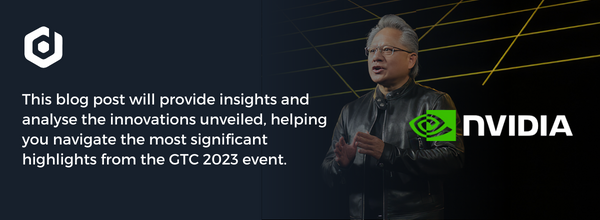NVIDIA’s 2023 GTC event was a spectacular showcase of the company’s extensive progress towards transforming industries with AI. From cutting-edge hardware and software to millions of developers, its ecosystem has grown immensely in size as both tech executives and data scientists alike explore new possibilities enabled by this unprecedented level of innovation.
GTC 2023 delivered in its promise of revealing pioneering technology sure to captivate. Our blog will help guide you on your journey through this groundbreaking event with insights that uncover and explore its most exciting innovations!
ChatGPT
NVIDIA’s technologies are fundamental to AI, with Huang recounting how NVIDIA was there at the very beginning of the generative AI revolution. Back in 2016 he hand-delivered to OpenAI the first NVIDIA DGX AI supercomputer — the engine behind the large language model breakthrough powering ChatGPT. Launched late last year, ChatGPT went mainstream almost instantaneously, attracting over 100 million users, making it the fastest-growing application in history.
“ChatGPT is the AI heard around the world. A new computing platform has been invented. The iPhone moment of AI has started. Accelerated computing and AI have arrived.” Jensen Huang, NVIDIA Founder and CEO
Parabricks 4.1
The upcoming 4.1 release of NVIDIA Parabricks, a suite of accelerated genomic analysis applications, goes further than ever before in accelerating sequencing alignment and increasing the accuracy of deep learning variant calling. NVIDIA Parabricks is free to use with an option for paid enterprise support. It contains a variety of optimized and AI-based industry-standard genomic tools delivering up to 80x acceleration over CPU-based tools and reducing compute costs by up to 50%. A 30x whole genome can now be analyzed in just 16 minutes compared to ~24 hours on CPU, translating to the analysis of up to 30,000 whole genomes a year on a single server.
Grace Superchip
NVIDIA’s new superchip, Grace Hopper, connects the Grace CPU and Hopper GPU over a high-speed 900GB/sec coherent chip-to-chip interface. Grace Hopper is ideal for processing giant datasets like AI databases for recommender systems and large language models, Huang explained.
“Customers want to build AI databases several orders of magnitude larger,” Huang said. “Grace Hopper is the ideal engine.”
Ultimately, the NVIDIA Grace CPU Superchip showcases a monumental leap forward in the computing sphere, promising to impact numerous fields such as healthcare, climate science, and autonomous systems, all while defining the future of computational possibilities.
NVIDIA BlueField-3 – in production
Nvidia also announced general availability for its BlueField-3 data processing unit (DPU) along with impressive early deployments including Oracle Cloud Infrastructure. First described in 2021 and now in production, BlueField-3 is Nvidia’s 3rd generation DPU featuring roughly 22 billion transistors. The new DPU supports Ethernet and InfiniBand connectivity at up to “400 gigabits per second and provides 4x more compute power, up to 4x faster crypto acceleration, 2x faster storage processing, and 4x more memory bandwidth compared to the previous generation of BlueField, according to Nvidia.”
NVIDIA DGX Cloud
To speed DGX capabilities to startups and enterprises racing to build new products and develop AI strategies, Huang announced NVIDIA DGX Cloud, through partnerships with Microsoft Azure, Google Cloud and Oracle Cloud Infrastructure to bring NVIDIA DGX AI supercomputers “to every company, from a browser.” DGX Cloud is optimized to run NVIDIA AI Enterprise, the world’s leading acceleration software suite for end-to-end development and deployment of AI. “DGX Cloud offers customers the best of NVIDIA AI and the best of the world’s leading cloud service providers,” Huang said.
Driving Innovation in Generative AI
To help drive down costs of inference processing for generative AI, NVIDIA has launched the H100 NVL with more performance and memory. Huang announced inference platforms for AI video, image generation, LLM deployment and recommender inference, that combine NVIDIA’s full stack of inference software with the latest NVIDIA Ada, Hopper and Grace Hopper processors — including the NVIDIA L4 Tensor Core GPU and the NVIDIA H100 NVL GPU.
Foundation AI Services
To accelerate the work of those seeking to harness generative AI, Huang announced NVIDIA AI Foundations, a family of cloud services for customers needing to build, refine and operate custom LLMs and generative AI trained with their proprietary data and for domain-specific tasks. NVIDIA announced that the company’s foundation model platform NeMo, is being extended into visualization and bio engineering fields as part of the new AI Foundations cloud services. NVIDIA added two Foundations based on NeMo for illustrations and biomedical engineering.
Conclusion
NVIDIA GTC 2023 was a sight to behold. Industry titans and innovators alike were treated to the cutting-edge of technology, from strategic partnerships that expand global ecosystems, to captivating keynotes full of inspirational announcements. It’s clear why CTOs, developers and IT fans across the world have their eyes —and ears— glued on this revolutionary company as it continues its ascendancy in pushing technological boundaries further than ever before.
As we reflect on their remarkable accomplishments since last year’s conference, one can only wonder what groundbreaking technology will be unveiled at next year’s keynote!
Read about the announcments from NVIDIA in full here.

